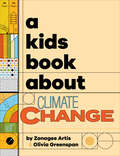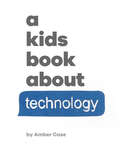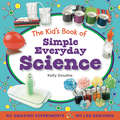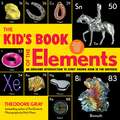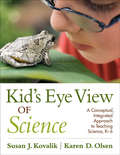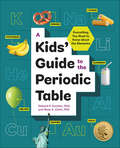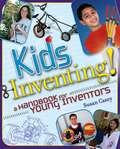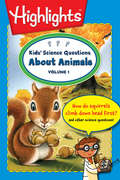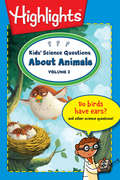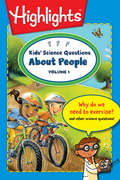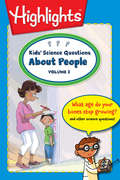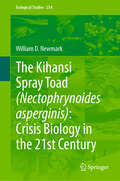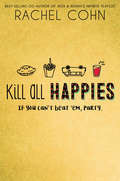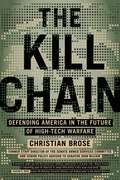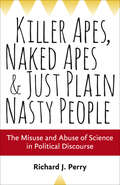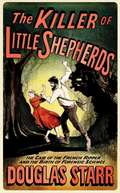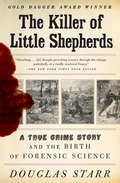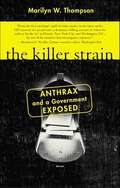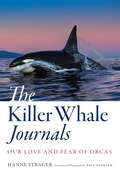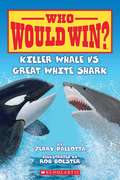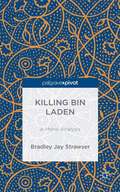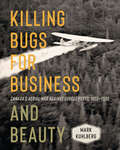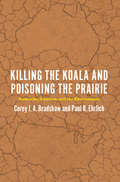- Table View
- List View
A Kids Book About Climate Change: Kids Are Ready (A Kids Book)
by Zanagee Artis Olivia GreenspanExplore the impact of climate change and empower kids to be proactive to protect our world.This is a kid's book about climate change. Climate change is a topic that can be overwhelming for kids and grownups. So if you're looking for the best place to better understand the climate crisis, look no further!This book helps kids aged 5-9 understand what climate change means, giving them the power to make a difference. Learn the facts about climate change, explain what the state of our planet is, how it got there, and give them hope to fight for their future.A Kids Book About Climate Change features: - A large and bold, yet minimalist font design that allows kids freedom to imagine themselves in the words on the pages.- A friendly, approachable and empowering, kid-appropriate tone throughout.- An incredible and diverse group of authors in the series who are experts or have first-hand experience of the topic.Tackling important discourse together! The A Kids Book About series are best used when read together. Helping to kickstart challenging, empowering, and important conversations for kids and their grownups through beautiful and thought-provoking pages. The series supports an incredible and diverse group of authors, who are either experts in their field, or have first-hand experience on the topic. A Kids Co. is a new kind of media company enabling kids to explore big topics in a new and engaging way. With a growing series of books, podcasts and blogs, made to empower. Learn more about us online by searching for A Kids Co.
A Kids Book About Nervous System Regulation (A Kids Book)
by Dr. Joy Malik-HasbrookLearn about the importance of nervous system regulation and how it helps to make us feel safe and connected – with each other and within ourselves.This is a kids’ book about nervous system regulation. The nervous system guides so much of what we do, from breathing and feeling to thinking and living! But our nervous systems can get dysregulated, which can make us feel disconnected or overwhelmed. This book was made to help kids aged 5-9 understand different stress responses and practice techniques to calm and regulate our nervous systems – all parts of being human!A Kids Book About Nervous System Regulation features: A large and bold, yet minimalist font design that allows kids freedom to imagine themselves in the words on the pages.A friendly, approachable, empowering and child-appropriate tone throughout.An incredible and diverse group of authors in the series who are experts or have first-hand experience of the topic.Tackling important discourse together! The A Kids Book About titles are best used when read together. Helping to kickstart important, challenging, and empowering conversations for kids and their grown-ups through beautiful and thought-provoking pages. The series supports an incredible and diverse group of authors, who are either experts in their field, or have first-hand experience on the topic. A Kids Co. is a new kind of media company enabling kids to explore big topics in a new and engaging way, with a growing series of books, podcasts and blogs made to empower. Learn more about us online by searching for A Kids Co.
Kids Book About Technology, A (A Kids Book)
by Amber CaseBuild a healthy relationship with the technology in your life!We're all cyborgs. It's true! We use technology every day in all aspects of our lives—but that's not a bad thing! The problem is when we let it take over our lives. This book will help kids and grownups alike reflect on their relationship with technology and learn to embrace the benefits of being unplugged.
The Kid's Book of Simple Everyday Science
by Kelly DoudnaThese 40 simple science activities will have young kids searching the house for everyday items to learn about temperature, pressure, water, air, heat, and plants! Each easy and fun activity includes how-to photos, simple instructions, short explanations, and introduces beginning math principles. With tips and extra information to extend the scientific experience, this book will get kids thinking like scientists in no time at all! The book includes: supply & tool lists, visual and text-based explanations, step-by-step instructions and photos, and safety information.
The Kid's Book of the Elements: An Awesome Introduction to Every Known Atom in the Universe
by Theodore GrayA fun, fascinating, and amazingly photographic exploration of the periodic table, for curious kids who want to understand how atoms and elements make up everything in the universe.In this very special kids' edition of Theodore Gray's The Elements, budding scientists, ages 6 to 9, will learn all about every element in the periodic table from the first element, Hydrogen (1), to the very last element, Oganesson (118). Filled with great big colorful photographs and fun facts for every element, The Kid's Book of The Elements is the perfect introduction to the fascinating world of chemistry and visual/tactile-based STEM/STEAM learning. This edition also includes 120 sturdy tear-out cards of each element for kids to play with and arrange on their own.
Kid’s Eye View of Science: A Conceptual, Integrated Approach to Teaching Science, K–6
by Susan J. Kovalik Karen D. OlsenRediscover science from a child's perspective and enhance your inquiry-based science toolbox with brain-based strategies that integrate science across content areas and improve student outcomes.
A Kids' Guide to the Periodic Table: Everything You Need to Know about the Elements
by Edward P. Zovinka Rose A. ClarkFrom aluminum to zinc—make it fun for kids 8 to 12 to discover all 118 elements on the periodic table!Discover the building blocks of the entire world! A Kids' Guide to the Periodic Table takes you on an incredible journey through history and science that will teach you all about the 118 elements that make up, well, everything!Go in-depth with awesome profiles on each and every element that provide all their important elemental stats (like their atomic number, state, group, and more), as well as awesome facts about the element and its discovery. Take what you know about science—and the world—to a new level as you discover what makes the periodic table of elements so amazing.A Kids' Guide to the Periodic Table includes:The periodic table explained—Learn about the creation of the periodic table and get tons of info to help you understand the groups, the order of elements, and more.Amazing discoveries—Explore how elements like neon, helium, and californium were discovered, as well as what they've helped scientists do.Fun for you—Find out how exciting science can be with an entertaining look into all the ways the elements affect your everyday life.A fun, fact-filled science adventure awaits you with A Kids' Guide to the Periodic Table!
Kids Inventing!
by Susan CaseyHave you ever seen inventors on TV or in the newspaper and thought, "That could be me!" Well, it certainly could-and this book shows you how. Kids Inventing! gives you easy-to-follow, step-by-step instructions for turning your ideas into realities for fun, competition, and even profit. From finding an idea and creating a working model to patenting, manufacturing, and selling your invention, you get expert guidance in all the different stages of inventing. You'll see how to keep an inventor's log, present your ideas, and work as part of a team or with a mentor. You'll meet inspiring kids just like you who designed their own award-winning inventions. And you'll see how to prepare for the various state and national invention contests held each year, as well as international competitions and science fairs.
Kids' Science Questions About Animals Volume 1
by Highlights For Children Debbie Palen Dave KlugJam-packed with questions and answers, this book and its companion, Kids' Science Questions About Animals: Volume 2, will entertain budding scientists who love to wonder why animals behave the way they do.
Kids' Science Questions About Animals Volume 2
by Highlights For Children Dave Klug Xiao XinJam-packed with questions and answers, this book and its companion, Kids' Science Questions About Animals: Volume 1, will entertain budding scientists who love to wonder why animals behave the way they do.
Kids' Science Questions About People Volume 1
by Highlights For Children Debbie Palen Dave KlugJam-packed with questions and answers, this book and its companion, Kids' Science Questions About People: Volume 2, will entertain budding scientists with interesting explanations of the human body, such as What happens when we exercise? and How do you get a sunburn?
Kids' Science Questions About People Volume 2
by Highlights For Children Scot Ritchie Dave KlugJam-packed with questions and answers, this book and its companion, Kids' Science Questions About People: Volume 1, will entertain budding scientists with interesting explanations of the human body, such as What makes people laugh? and How do our stomachs grumble?
The Kihansi Spray Toad (Ecological Studies #254)
by William D. NewmarkThe captive breeding and reintroduction of highly threatened species are among the most challenging conservation interventions and often represent the final tool in a comparatively small toolbox to conserve rapidly declining species. This book details the species recovery program that was designed and implemented over two decades to conserve the Kihansi Spray Toad (Nectophrynoides asperginis), an extinct-in-the-wild tropical amphibian. More than 20 international and national institutions were involved in the design and implementation of the species recovery program. This complex two-decade effort highlights the challenges of conserving highly threatened tropical amphibians and integrating conservation with development in the 21st century. This volume will appeal to biologists, conservation and development practitioners, and institutions and individuals concerned about the conservation of biodiversity.
Kill All Happies
by Rachel CohnLast Call at Happies! Tonight, 8 P.M. Senior Class Only! Please with the Shhhh?.This is it. Graduation. And Vic Navarro is throwing the most epic party Rancho Soldado has ever seen. She's going to pull off the most memorable good-bye ever for her best friends, give Happies-the kitschy restaurant that is her desert town's claim to fame-a proper send-off into bankruptcy, and oh yes, hook up with her delicious crush, Jake Zavala-Kim. She only needs to keep the whole thing a secret so that her archnemesis, Miss Ann Thrope, Rancho Soldado's nightmare Town Councilwoman and high school Economics teacher, doesn't get Vic tossed in jail. With the music thumping, alcohol flowing, bodies mashing, and Thrope nowhere to be seen, Vic's party is a raging success. That is, until Happies fans start arriving in droves to say good-bye, and storm the deserted theme park behind the restaurant. Suddenly what was a small graduation bash is more like Coachella on steroids with a side of RASmatazz pie. The night is so not going as planned. And maybe that's the best plan of all.
The Kill Chain: Defending America in the Future of High-Tech Warfare
by Christian BroseFor generations of Americans, our country has been the world's dominant military power. How the US military fights, and the systems and weapons that it fights with, have been uncontested. That old reality, however, is rapidly deteriorating. America's traditional sources of power are eroding amid the emergence of new technologies and the growing military threat posed by rivals such as China. America is at grave risk of losing a future war.As Christian Brose reveals in this urgent wake-up call, the future will be defined by artificial intelligence, autonomous systems, and other emerging technologies that are revolutionizing global industries and are now poised to overturn the model of American defense. This fascinating, if disturbing, book confronts the existential risks on the horizon, charting a way for America's military to adapt and succeed with new thinking as well as new technology. America must build a battle network of systems that enables people to rapidly understand threats, make decisions, and take military actions, the process known as "the kill chain." Examining threats from China, Russia, and elsewhere, The Kill Chain offers hope and, ultimately, insights on how America can apply advanced technologies to prevent war, deter aggression, and maintain peace.
Killer Apes, Naked Apes, and Just Plain Nasty People: The Misuse and Abuse of Science in Political Discourse
by Richard J. PerryMisunderstood—or deliberately twisted—biological science leads to overheated rhetoric and bad policy.We like to think that science always illuminates. But the disturbing persistence of the concept of biological determinism—the false idea that human behavior is genetically fixed or inherently programmed and therefore is not susceptible to rapid change—shows that scientific research and concepts can be distorted to advance an inhumane and sometimes deadly political agenda. It was biological determinism that formed the basis of the theory of eugenics, which in turn led to the forced sterilization of "misfits" and the creation of Nazi death camps.In Killer Apes, Naked Apes, and Just Plain Nasty People, anthropologist Richard J. Perry delivers a scathing critique of determinism. Exploring the historical context and enduring popularity of the movement over the past century and a half, he debunks the facile and the reductionist thinking of so many popularizers of biological determinism while considering why biological explanations have resonated in ways that serve to justify deeply conservative points of view.Moving through time, from the prevalence of overt racism in the late nineteenth and early twentieth centuries to "human nature" arguments, from the rise of sociobiology in the 1970s to the current fixation on evolutionary psychology, the book argues that both history and cross-cultural studies amply demonstrate the human capacity for growth and self-determination. Clearly written, conversational, and rationally argued, this book promotes sound and careful research while skewering the bogus ideological assertions that have been used to justify colonialism, slavery, gender discrimination, neoliberal economic policies, and the general status quo.
Killer Instinct: The Popular Science of Human Nature in Twentieth-Century America
by Nadine WeidmanA historian of science examines key public debates about the fundamental nature of humans to ask why a polarized discourse about nature versus nurture became so entrenched in the popular sciences of animal and human behavior. Are humans innately aggressive or innately cooperative? In the 1960s, bestselling books enthralled American readers with the startling claim that humans possessed an instinct for violence inherited from primate ancestors. Critics responded that humans were inherently loving and altruistic. The resulting debate—fiercely contested and highly public—left a lasting impression on the popular science discourse surrounding what it means to be human. Killer Instinct traces how Konrad Lorenz, Robert Ardrey, and their followers drew on the sciences of animal behavior and paleoanthropology to argue that the aggression instinct drove human evolutionary progress. Their message, spread throughout popular media, brought pointed ripostes. Led by the anthropologist Ashley Montagu, opponents presented a rival vision of human nature, equally based in biological evidence, that humans possessed inborn drives toward love and cooperation. Over the course of the debate, however, each side accused the other of holding an extremist position: that behavior was either determined entirely by genes or shaped solely by environment. Nadine Weidman shows that what started as a dispute over the innate tendencies of animals and humans transformed into an opposition between nature and nurture. This polarized formulation proved powerful. When E. O. Wilson introduced his sociobiology in 1975, he tried to rise above the oppositional terms of the aggression debate. But the controversy over Wilson’s work—led by critics like the feminist biologist Ruth Hubbard—was ultimately absorbed back into the nature-versus-nurture formulation. Killer Instinct explores what happens and what gets lost when polemics dominate discussions of the science of human nature.
The Killer of Little Shepherds: The Case of the French Ripper and the Birth of Forensic Science
by Douglas StarrAt the end of the nineteenth century, serial murderer Joseph Vacher, dubbed "The Killer of Little Shepherds," terrorized the French countryside. He eluded authorities for years-until he ran up against prosecutor Emile Fourquet and Dr. Alexandre Lacassagne, the era's most renowned criminologist. The two men typified the Belle Epoque, a period of immense scientific achievement and fascination with its promise to reveal the secrets of the human condition. With high drama and stunning detail, Douglas Starr recounts the infamous crime and punishment of Vacher, interweaving the story of how Lacassagne and his colleagues developed forensics as we know it. We see one of the earliest uses of criminal profiling, as Fourquet painstakingly collects eyewitness accounts, leading to Vacher's arrest. And we see the twists and turns of the celebrated trial: to disprove Vacher's defense by reason of insanity, Fourquet recruits Lacassagne, who had revolutionized criminal science: refining the use of blood spatter evidence, systematizing the autopsy and doing ground-breaking research in psychology. Lacassagne's forensic investigation ranks among the greatest of all time, and its denouement is gripping. An important contribution to the history of medicine and criminal justice, impressively researched and thrillingly told.
The Killer of Little Shepherds
by Douglas StarrA riveting true crime story that vividly recounts the birth of modern forensics.At the end of the nineteenth century, serial murderer Joseph Vacher, known and feared as "The Killer of Little Shepherds," terrorized the French countryside. He eluded authorities for years--until he ran up against prosecutor Emile Fourquet and Dr. Alexandre Lacassagne, the era's most renowned criminologist. The two men--intelligent and bold--typified the Belle Époque, a period of immense scientific achievement and fascination with science's promise to reveal the secrets of the human condition. With high drama and stunning detail, Douglas Starr revisits Vacher's infamous crime wave, interweaving the story of how Lacassagne and his colleagues were developing forensic science as we know it. We see one of the earliest uses of criminal profiling, as Fourquet painstakingly collects eyewitness accounts and constructs a map of Vacher's crimes. We follow the tense and exciting events leading to the murderer's arrest. And we witness the twists and turns of the trial, celebrated in its day. In an attempt to disprove Vacher's defense by reason of insanity, Fourquet recruits Lacassagne, who in the previous decades had revolutionized criminal science by refining the use of blood-spatter evidence, systematizing the autopsy, and doing groundbreaking research in psychology. Lacassagne's efforts lead to a gripping courtroom denouement. The Killer of Little Shepherds is an important contribution to the history of criminal justice, impressively researched and thrillingly told.From the Hardcover edition.
The Killer Strain: Anthrax and a Government Exposed
by Marilyn W. ThompsonA lethal germ is unleashed in the U.S. mail. A chain of letters spreads terror from Florida to Washington, D.C., from New York to Connecticut, from the halls of Congress to the assembly lines of the U.S. Postal Service. Five people die, and ten thousand more line up for antibiotics to protect against exposure. The government, already outsmarted by the terrorist hijackers of 9/11, leaves its workers vulnerable and a diabolical killer on the loose.Based on hundreds of hours of interviews and a review of thousands of pages of government documents, The Killer Strain is the definitive account of the year in which bioterrorism became a reality in the United States. Revealing the little-known victims and unsung heroes in the anthrax debacle, investigative reporter Marilyn Thompson also examines the FBI's slow-paced investigation of the crimes and the unprecedented scientific challenges posed by the case.The Killer Strain, more than just a thrilling read, is also a clarion wake-up call. It shows how billions of dollars and a decade of elaborate bioterror dress rehearsals meant nothing in the face of a real attack -- and how we may still be at risk.
The Killer Whale Journals: Our Love and Fear of Orcas
by Hanne StragerExperience the hauntingly beautiful world of orcas, and discover the stories that unfold when humans enter oceans alongside them.When intrepid biology student Hanne Strager volunteered to be the cook on a small research vessel in Norway's Lofoten Islands, the trip inspired a decades-long journey into the lives of killer whales—and an exploration of people's complex relationships with the biggest predators on earth. The Killer Whale Journals chronicles the now internationally renowned science writer's fascinating adventures around the world, documenting Strager's personal experiences with orcas in the wild. Killer whales' incredible intelligence, long life spans, and strong family bonds lead many people to see them as kindred spirits in the sea. But not everyone feels this way—like wolves, orcas have been both beloved and vilified throughout human history. In this absorbing odyssey, Strager traces the complicated relationship between humans and killer whales, while delving into their behavior, biology, and ecology. She brings us along in her travels to the most remote corners of the world, battling the stormy Arctic seas of northern Norway with fellow biologists intent on decoding whale-song, interviewing First Nations conservationists in Vancouver, observing Inuit hunters in Greenland, and witnessing the dismantling of black market "whale jails" in the Russian wilderness of Kamchatka. Through these captivating stories, Strager introduces us to a diverse cast of characters from Inuit elders to Australian Aboriginal whalers and guides us through the world's wild waters, from fjords above the Arctic circle in Norway to the poaching-infested waters off Kamchatka. Featuring astonishing photographs from famed nature photographer and conservationist Paul Nicklen, The Killer Whale Journals reveals rare and intimate moments of connection with these fierce, brilliant predators.
Killer Whale Vs. Great White Shark (Who Would Win?)
by Jerry Pallotta Rob BolsterThis nonfiction reader compares and contrasts two ferocious underwater creatures. Kids learn about the killer whale and the great white shark's anatomies, behaviors, and more. This book is packed with photos, charts, illustrations, and amazing facts.
Killing bin Laden: A Moral Analysis
by Bradley Jay StrawserKilling bin Laden: An Ethical Analysis is a short treatise on the possible ethical justification for the U. S. mission to kill Osama bin Laden. After rejecting the standard justifications most commonly used in support of the killing, Strawser ultimately argues that the killing was ethically permissible as an act of defensive harm on behalf of innocents. The book contends bin Laden was morally responsible for a collection of unjust threats such that he was liable to be killed. Moreover, the many unique features of the bin Laden case -such as the use of pre-emptive harm and the collective agency of al-Qaeda - do not defeat that liability. The monograph also includes discussions of the apparent violation of Pakistan's sovereignty and the morally dubious celebrations of bin Laden's death, among other morally relevant issues.
Killing Bugs for Business and Beauty: Canada’s Aerial War against Forest Pests, 1913–1930
by Mark KuhlbergKilling Bugs for Business and Beauty examines the beginning of Canada’s aerial war against forest insects and how a tiny handful of officials came to lead the world with a made-in-Canada solution to the problem. Shedding light on a largely forgotten chapter in Canadian environmental history, Mark Kuhlberg explores the theme of nature and its agency. The book highlights the shared impulses that often drove both the harvesters and the preservers of trees, and the acute dangers inherent in allowing emotional appeals instead of logic to drive environmental policy-making. It addresses both inter-governmental and intra-governmental relations, as well as pressure politics and lobbying. Including fascinating tales from Cape Breton Island, Muskoka, and Stanley Park, Killing Bugs for Business and Beauty clearly demonstrates how class, region, and commercial interest intersected to determine the location and timing of aerial bombings. At the core of this book about killing bugs is a story, infused with innovation and heroism, of the various conflicts that complicate how we worship wilderness.
Killing the Koala and Poisoning the Prairie: Australia, America, and the Environment
by Corey J. A. Bradshaw Paul R. EhrlichThough separated by thousands of miles, the United States and Australia have much in common. Geographically both countries are expansive--the United States is the fourth largest in land mass and Australia the sixth--and both possess a vast amount of natural biodiversity. At the same time, both nations are on a crash course toward environmental destruction. Highly developed super consumers with enormous energy footprints and high rates of greenhouse-gas emissions, they are two of the biggest drivers of climate change per capita. As renowned ecologists Corey J. A. Bradshaw and Paul R. Ehrlich make clear in Killing the Koala and Poisoning the Prairie, both of these countries must confront the urgent question of how to stem this devastation and turn back from the brink. In this book, Bradshaw and Ehrlich provide a spirited exploration of the ways in which the United States and Australia can learn from their shared problems and combine their most successful solutions in order to find and develop new resources, lower energy consumption and waste, and grapple with the dynamic effects of climate change. Peppering the book with humor, irreverence, and extensive scientific knowledge, the authors examine how residents of both countries have irrevocably altered their natural environments, detailing the most pressing ecological issues of our time, including the continuing resource depletion caused by overpopulation. They then turn their discussion to the politics behind the failures of environmental policies in both nations and offer a blueprint for what must be dramatically changed to prevent worsening the environmental crisis. Although focused on two nations, Killing the Koala and Poisoning the Prairie clearly has global implications--the problems facing the United States and Australia are not theirs alone, and the solutions to come will benefit by being crafted in coalition. This book provides a vital opportunity to learn from both countries' leading environmental thinkers and to heed their call for a way forward together.
